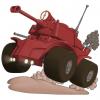@Gian-Reto
Yeah, you're right. I wasn't thinking of isometric art like that because it seems like a completely different art style, rather then just a change of POV.
I want to go 3D for my isometric game, just because it's easier from a programming aspect as well (at least from what I've read). I guess my best bet is to take on board an artist who can do a specific range of things, and then outsource any other artist work I need.
That still leaves me with the question of: how much realistically can a single artist do at once? I'm looking for the artist to learn along with me, so it's not the skills I need - but the knowledge of how many skills they can realistically learn.
I don't know if I'm explaining this very well.
A LOT depends on your art style.
Go with a simple art style, like the stylized low poly style that became trendy among some Indie hipster games, and your artist, if he is a good artist, will churn out assets like ther is no tomorrow (though, to be realistic, stuff still takes time to create in a reasonable quality. There is a certain amount of overhead because of all the needed steps to create even a textureless, animated 3D character).
Ask your artist to create a fully rigged, highly detailed high poly character in AAA quality and he will spend months on a single character.
So really make sure you tell the artist EXACTLY what you need, and you make sure that you cut corners whereever possible.
- Don't want the cam to be able to zoom in? Make sure the texture detail is not excessive for your PoV. Your artist can omit a ton of details on the normal characters, and just spend a little bit more time on the assets that are bigger in your scene.
- Working with textboxes anyway? Drop facial animations, your player will hardly see the facial animations anyway in a isometric PoV, and creating proper facial animations can take a ton of time.
- Do you REALLY need organic creatures in your game? With mechanical units you save a ton of time and headaches on rigging and animation.
- Make sure you approach your artist with a clear brief of what you need. Like a clear brief, maybe with simple sketches, for every asset you need. Failing that, make sure you give him additional time to come up with a concept for you to approve (and of course, you will need to pay for that too)
- Make sure you have everything tested before telling your artist to start churning out those assets. There are a ton of possible mistakes or things that just don't work with your choice of engine, render, game concept or whatever else is involved on the non-artsy side. Make sure you have a testmodel, run through the whole pipeline once before the artist starts churning out assets like mad.
Having to redo a testpiece is not so bad. Having to redo 50+ assets will become expensive fast.
In general, things take way longer than you think to produce in 3D. The fastest thing is to buy stock assets, if they fit your needs (if you need to re-adjust them, they might again take a ton of time). The second fastest thing is kitbashing what you need from pre-existing models (which is what most pro 3D artists do most of the time anyway, they will have a HUGE library of stock and their own prior art they can work with).
The slowest is creating stuff from scratch.
So if you think about teaming up with an inexpierienced 3D artist, keep that in mind. Many newbies like working from scratch, it lets them learn more... they also lack the library of models to work with and kitbash. And of course, stock art can range from cheap to very expensive.
Still, set aside a budget for getting ahold of stock art and kitbash piece libraries. It can save your artist a ton of time!










